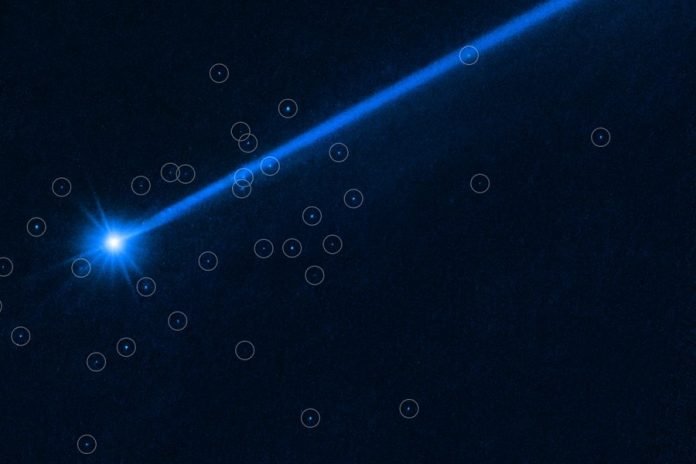
NASA, our space experts, recently tried a bold experiment.
They wanted to see if they could push an asteroid off its path, just in case one ever threatened Earth.
They used a spacecraft called DART and crashed it into a nearby asteroid named Dimorphos. Good news: it worked! But there was a surprising twist.
The hit created a “cloud” of big rocks, called boulders, that shot off the asteroid. Imagine you drop a watermelon, and it breaks into smaller pieces.
That’s what happened, but in space! David Jewitt, a smart space scientist from UCLA, led a team that studied this.
He said the boulders flying around were like pieces from an exploding hand grenade. And these pieces can be just as dangerous as the big asteroid itself.
Why? Because if these boulders hit Earth, they’d come down really, really fast. One of the bigger boulders could even hit with the same force as the powerful bomb dropped on Hiroshima during World War II.
That’s a scary thought.
But don’t worry too much! The asteroid Dimorphos and the boulders were never a danger to us. NASA picked this asteroid because it was far from Earth (6 million miles away) and small enough for their experiment.
The DART spacecraft hit the asteroid at a whopping 13,000 miles per hour. That hit changed the way Dimorphos moved around its twin asteroid, Didymos. It was only a tiny change, but enough for NASA to see that their idea worked.
However, there was that unexpected part. The hit knocked off 37 boulders from the asteroid. Some were as small as 3 feet, and others were as big as 22 feet. None of them are coming towards Earth, but this shows that we have to think about the smaller rocks too if we ever try this on an asteroid that might hit us.
The powerful Hubble Space Telescope took pictures of these boulders. Before DART hit the asteroid, there were similar boulders just sitting on its surface. After the crash, those boulders were flying around in space. The Hubble telescope’s photos are so clear that scientists can even see details of these faraway boulders.
Jewitt mentioned that if they keep watching the boulders with Hubble, they could learn more about how and where they flew off. That’s like watching which way the pieces of our dropped watermelon go. It would help scientists understand the whole picture better.
And there’s more exciting news! In 2026, a spacecraft from Europe called HERA will visit Dimorphos. It will study everything up close and learn even more about the DART experiment. This will help us plan better ways to protect Earth from dangerous asteroids in the future.
In Short: NASA successfully tested a way to move asteroids, but it made smaller rocks fly off. Scientists are learning from this to make sure we can protect our planet in the best way.
Follow us on Twitter for more articles about this topic.
Source: UCLA.



